|
The
AMA's
Delta Dart program has been around a long time, and is still its primary
tool for introducing young kids to the model aviation hobby. The Delta Dart's
easily and quickly built, strong, forgiving frame and simple dry tissue
covering makes for almost guaranteed success with all newcomers... and they're
cheap to boot. This Thermal Dart is a step up really only in size with not
not too much added complexity. Its 24" wingspan, versus the Delta Dart's
12" wingspan, provides for longer flights and make it easier to see. Frank
Ehling designed both the original Delta Dart and the Thermal Dart. Thermal
Dart
Frank Ehling
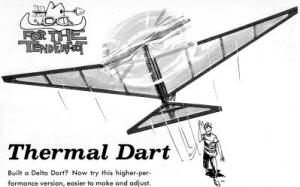
Built a Delta Dart? Now try this higher-performance version, easier
to make and adjust.
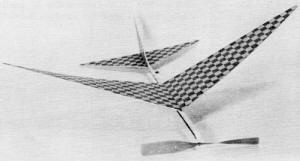
Size of Thermal Dart permits experimenting with wood sizes to improve
performance, but keep same areas and dimensions.
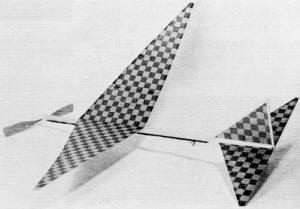
In case you wonder, checkerboard pattern tissue should be available
at leading hobby shops. Prop sanded to thin and lighten.
Both photos, Frank Pierce |
Although this model is easy to construct, building a Delta Dart or AMA Cub
first will aid in making a better Thermal Dart. It uses a larger propeller
and a stronger rubber motor than the Delta Dart, thus enabling it to climb
higher, and has a larger wing, which allows it to glide longer. By gluing
the wing to the wing saddle, the wing can slide along the motor stick, making
it possible to adjust the model to obtain good glides without stalling after
the rubber is unwound. A little practice flying will indicate the best wing
location for a smooth glide. Begin construction by laying Saran
Wrap over the entire full-size plan; over this place the tissue covering.
Hold both layers in place with small pieces of Scotch Tape at the corners.
Start on the wing by cutting the leading and trailing edges from 3/32 x
1/4". Cement them to the tissue and then add the ribs, using as little glue
as possible. To make the wing saddle, cement a piece of 1/8" sq. directly
below the dihedral joint (the two center ribs) when putting the dihedral
in the wing. When this has dried, the side of the saddle can be cut from
1/16" sheet and cemented to the 1/8" sq. as shown on the front view of the
wing. The stabilizer (tail) is constructed like the wing. However,
note that the stabilizer and rudder are made out of 1/16 x 1/8". It is important
to keep the tail end of this model light. When building the rudder, apply
cement only within the rudder area on the motor stick. Bend a paper clip
and cement it to the motor stick as shown. On the front end put the prop
unit in place. Assemble the model by slipping the wing saddle onto the motor
stick and hold it in place with two small rubber bands. Get a loop of 1/4"
flat rubber 18" long and connect it to the prop and rear hooks. Tie the
rubber strand into a loop using a square knot. Place the wing as
indicated, and wind the propeller until the rubber has a single row of knots.
Release the propeller and gently push the model forward. Observe the flight.
If the model doesn't climb, slide the wing saddle forward. If it climbs
up and then stalls, move the wing back. When a good climb and smooth glide
are achieved, wind the propeller to two rows of knots and be ready for a
good chase after the model. After successfully building and flying
this model, construct a second wing using 1/16 x 1/8" wood for the entire
assembly. The wing is cemented where the first wing had been balanced on
the motor stick. This will produce a lighter model, which will climb and
glide much better. However, it is more liable to break and should be flown
outdoors only when it is calm.
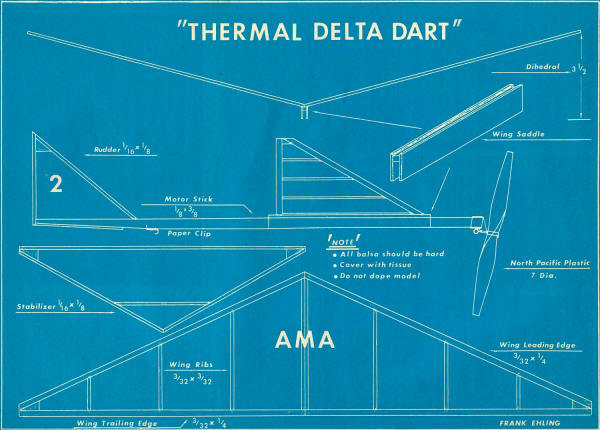
Thermal Dart Plans
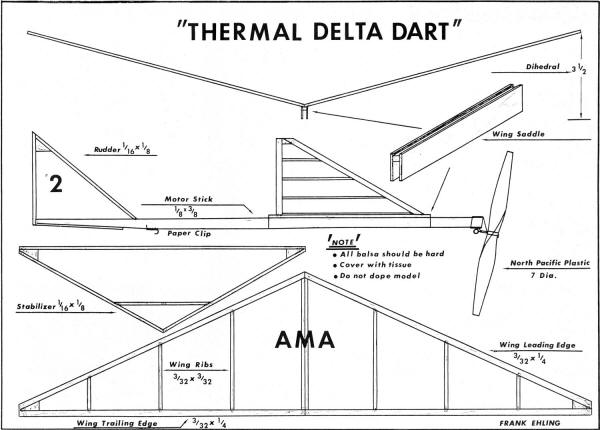
Thermal Dart Plans (Black & White)
Notice:
The AMA Plans Service offers a
full-size version of many of the plans show here at a very reasonable cost. They
will scale the plans any size for you. It is always best to buy printed plans because
my scanner versions often have distortions that can cause parts to fit poorly. Purchasing
plans also help to support the operation of the
Academy of Model Aeronautics - the #1
advocate for model aviation throughout the world. If the AMA no longer has this
plan on file, I will be glad to send you my higher resolution version.
Try my Scale Calculator for
Model Airplane Plans.
Posted
June 29, 2013
|



